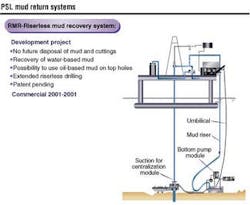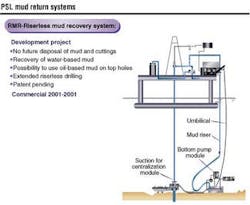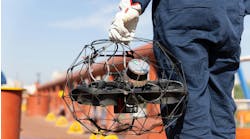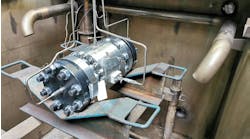Detachable artificial mud lift system has applications for all depths
To overcome narrow drilling margins, several artificial mud lift systems are in the development or testing phases. One such system, designed by PSL, is based on a technology created to eliminate cuttings on the seafloor. Roger Stave, PSL's Development Manager, said the system was originally designed to meet ever-tightening environmental regulations in the North Sea.
As regulators moved closer to banning seabed disposal of cuttings completely, PSL decided to develop a system that would comply with this potential ban. The goal was to bring cuttings and drilling fluid from the seafloor to the surface for separation and cleaning, and the disposal of cuttings.
The design that came about is the existing Cuttings Transport Systems (CTS) used in the North Sea to disperse cuttings and avoid collection on subsea templates. The technology is also proven by work the company did with BP on its drill cuttings initiative, where drill cuttings were lifted from the seabed to the deck of the North West Hutton platform located in 472 ft water depth. The initiative looked at developing and proving technology for removing existing contaminated cuttings piles. By controlling the mud pressure, PSL's Riserless Mud Lift Recovery System consists of the Riserless Mud Recovery System (RMR) and Controlled Mud Pressure System (CMP). Both are patent pending. The RMR system meets the original goal of zero discharge during surface/tophole drilling and will allow for greater access to sensitive fishing areas and deepwater fields.
The object of PSL's system was not to combat the limits of deepwater drilling, but to recover the drilling fluids and keep drill cuttings from accumulating on the seabed. The PSL design is based on a Discflo pump. The Discflo pump is similar in principal to a centrifugal pump, but can handle larger cuttings and more solids as well as more viscous fluids such as drilling fluid and drill cuttings. Instead of the vanes used to generate pressure inside a centrifugal pump, the Discflo uses a disc on which the heavier viscosity of the medium actually helps to increase efficiency.
How it operates
Well fluids in the artificial lift system move conventionally down the drill pipe, into the well, up the annulus, but are diverted, at the seabed into the subsea pump unit. This artificial lift system operates off power provided by an Electrical Submersible Pump (ESP), which is lowered to the seabed on winches and hooked up by a remotely operated vehicle (ROV). The entire hook up of a conventional CTS system takes only two hours, Stave said. The fluid and cuttings are pumped to the surface equipment for conditioning before being returned down hole.
Because the system uses a variable speed drive, the pump rate can be adjusted to control the effective circulating density (ECD). The pump speed is controlled automatically from the driller's control system. There is a pressure transmitter installed on the wellhead feeding a signal to the drilling control system. The pump is controlled to maintain a set suction/wellhead pressure. If shallow gas were detected by the system, a pressure alarm would sound and the system would manually disconnect at the wellhead. In addition, sonar and cameras are used to inspect the connection at the wellhead. If there is a problem, the system can be manually disconnected. If high pressure were detected by the system, there would be an automatic disconnection. In a case where there is a failure in the system or human error, the system is designed to fail on the suction side of the pump. This means the hose would burst before any gas kick reaches the pump equipment.
The fluid is delivered to the rig through an independent return line. Both the pump unit and the return line are installed independent of the drilling rig and wellhead and may hence be preinstalled by a vessel.
The basic components of the system include a Suction and Centralization Module (SCM) used on the wellhead for collecting drill fluid and cuttings during the top-hole drilling. This unit maintains a wellhead pressure equal to the static seawater pressure, minimizing the sealing requirements for the unit. The SCM has been successfully used to recover cuttings in over 100 wells, Stave said. Other components in the system are the control containers for the subsea pumps, umbilicals, and winches to provide power and assist with the installation of the bottom pump modules. The bottom pump modules transport the cuttings from the seabed.
This system offers advantages of extended riserless drilling using weighted mud while achieving the goal of zero discharge. In addition, the operator may save significant operational and investment costs.
The CMP system is designed for Dual Gradient type drilling with a BOP and drilling riser installed. The wellhead pressure can be regulated to match the pressure of the liquid column in the riser, or can be adjusted to equal the seawater pressure. Regardless of the mud weight used, the pump can control the ECD adapting to the drilling conditions. The same system configuration, pump and return line as for RMR can be used. No rotating control head is required, and it is safe and easy to trip in and out of the hole and close to the BOP. It is also easy to revert to conventional drilling if desired and the system may be disconnected and relocated without lost rig time.
There are a number of ways these systems can be used, depending on the water depth and capacity of the particular rig. For deepwater, a tensioned riser would carry mud returns to the surface. This could be pre-installed from a dive support vessel. A version of this system would be used during the sections of the well that require artificial mud lift, then disconnected and moved to the next drilling site.
The pump on the seabed could also be recovered for use on another well. The pump could also be pulled during drilling, without halting operations, if a problem develops. This riser system would be constructed from 7-9-in. casing pipe, with buoyancy attached.
Applications
If the system becomes widely used and thus standardized, Stave said, it could save operators as much as $3 million per well in terms of reduced fluid loss, fewer casing strings, and simplified logistics.
Beyond this savings in deepwater, the system offers a solution for the shallow water flow problems common in several shallow and deepwater sites. The solution does not require any significant modification of the rig and is not integrated into the systems of a particular rig. This means it could be rented out for a job, recovered, and used elsewhere.
The CMP design is such that a low-pressure riser fitted out with the system can turn it on and off with a simple remote controlled valve. Open the valve and the mud returns are diverted; close the valve and the drilling returns to normal.
In cases where heavy muds are used, the valve doesn't even have to be located at the seabed. It could be placed as high as halfway up the riser. This saves on casing, cabling, and power costs. Additional savings come in terms of power consumption. Stave said the system increases the efficiency of a rig's mud pumps by reducing the backpressure. This means the same mud pumps can operate on half the power required on a conventional system.




